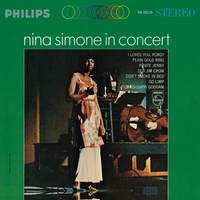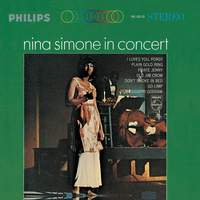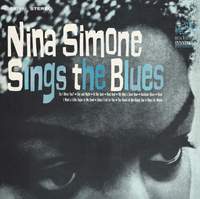Classic Recordings,
Nina Simone in Concert
Some artists become better known for their ‘greatest hits’ collections rather than individual albums, usually because they recorded over a long span and in a wide variety of styles, and this is a category that Nina Simone tends to fall into. Certainly until a few years ago I relied on my trusty best-of compilation when I wanted a Nina fix, which meant I was missing out on excellent albums like Nina Sings the Blues and my Classic Album choice Nina Simone in Concert, powerful artistic statements that reflected the turbulent times she lived through and actively participated in. Simone is also an artist whose music tends to fall in between genre definitions, as aside from jazz she worked in soul, rhythm & blues, pop, gospel and torch-songs. In some circles her music isn’t considered jazz-based enough, meaning she didn’t even get an entry in the Penguin Guide to Jazz.
 Born Eunice Kathleen Waymon in Tryon, North Carolina on February 21, 1933, to Mary Kate Waymon, a Methodist minister, and John Divine Waymon, a handyman who was also a part-time preacher, Simone was demonstrating her precocious musical ability as young as three years of age, when she would pick out tunes on the family’s piano, an instrument she would soon be playing in Sunday church services. Simone was recommended to teacher Muriel Mazzanovich, who gave her a thorough grounding in classical piano music, leading to a lifelong love for the music of Beethoven, Brahms, Bach and Schubert (when asked in an interview in the nineties which pop and rock artists she liked she frostily said ‘I don’t’, going on to declare she only listened to classical music). After graduating from high school she received a grant to study on a summer course at the Juilliard School of Music, and then set her hopes on gaining admission to the Curtis Institute of Music in Philadelphia (to the extent that the family relocated to the area), but was turned down (Simone argued it was due to racial prejudice). She took private lessons from pianist Vladimir Sokoloff however, supporting herself by finding paid work as a pianist in a bar and grill in Atlantic City, playing rhythm and blues and the pop hits of the day. Here she gave herself the name Nina Simone (Nina was a nickname a boyfriend gave her, and Simone came from seeing a film starring Simone Signoret at the cinema), and was offered more money to sing as well as play piano. Coming from a religious family who would not approve of her playing ‘the devil’s music’ in downtown bars she assumed her stage name to avoid being found out by her religious parents.
Born Eunice Kathleen Waymon in Tryon, North Carolina on February 21, 1933, to Mary Kate Waymon, a Methodist minister, and John Divine Waymon, a handyman who was also a part-time preacher, Simone was demonstrating her precocious musical ability as young as three years of age, when she would pick out tunes on the family’s piano, an instrument she would soon be playing in Sunday church services. Simone was recommended to teacher Muriel Mazzanovich, who gave her a thorough grounding in classical piano music, leading to a lifelong love for the music of Beethoven, Brahms, Bach and Schubert (when asked in an interview in the nineties which pop and rock artists she liked she frostily said ‘I don’t’, going on to declare she only listened to classical music). After graduating from high school she received a grant to study on a summer course at the Juilliard School of Music, and then set her hopes on gaining admission to the Curtis Institute of Music in Philadelphia (to the extent that the family relocated to the area), but was turned down (Simone argued it was due to racial prejudice). She took private lessons from pianist Vladimir Sokoloff however, supporting herself by finding paid work as a pianist in a bar and grill in Atlantic City, playing rhythm and blues and the pop hits of the day. Here she gave herself the name Nina Simone (Nina was a nickname a boyfriend gave her, and Simone came from seeing a film starring Simone Signoret at the cinema), and was offered more money to sing as well as play piano. Coming from a religious family who would not approve of her playing ‘the devil’s music’ in downtown bars she assumed her stage name to avoid being found out by her religious parents.
Simone’s first break came when she recorded a version of Gershwin’s I Loves You Porgy which hit the Billboard Top 20 in 1959, and would be her only real US chart hit. Her first album Little Girl Blues included one of her most enduring recordings, the jazz standard My Baby Just Cares For Me, but she unwisely she sold her rights to the album outright for $3,000, earning nothing from it when it was released as a single in 1980 (the first of many unlucky or ill-advised business decisions).
It was as the civil rights movement gathered pace in the early sixties that Simone found her true calling, expressing her anger in a series of uncompromising songs like Four Women, To Be Young, Gifted and Black, and most explicitly Mississippi Goddam, ‘my first civil rights song’ as she called it. A response to the murder of civil rights activist Medgar Evers on June 12, 1963, and the killing of four children in the 16th Street Baptist Church bombing in Birmingham, Alabama shortly after on September 15 of the same year, the song became an anthem for the movement. The most famous version is as the final track on Nina Simone in Concert, taken from three performances at Carnegie Hall in New York in March and April of 1964. A single version was taken from the album, and was banned in several Southern states, nominally for having ‘Goddam’ in the title, but in reality for its angry protest at the killings, underlined by the fact that several boxes of the promotional singles sent out for radio promotion were returned to the label snapped in two. 
Part of the genius of the song is the way it wrong-foots the listener into thinking it’s a jaunty show tune, cleverly alluding to the tradition of nineteenth-century minstrel theatre where white performers would ‘black-face’ and perform gentrified versions of African-American songs. The music is actually based on a refrain from Bertolt Brecht and Kurt Weill’s Alabama Song, from the political play Mahagonny-Songspiel, and over the intro Simone announces ‘The name of this tune is Mississippi Goddam…and I mean every word of it’. She later comments ‘this is a show tune, but the show hasn’t been written for it yet’, as the song builds in anger and resentment detailing not only the explicit abuse African-Americans were suffering, but also the patronising white middle-class platitudes about how they might best assimilate. It’s as powerful a protest song as any ever recorded, an absolute tour-de-force from Simone.
Many of the songs that precede it on the album are similarly politically charged, with a genuinely creepy version of Brecht and Weill’s Pirate Jenny from The Threepenny Opera, the choice of which draws inevitable parallels between thirties Europe and sixties America (there’s no ignoring the hostility with which she hisses the line ‘And as they pile up the bodies I say – that’ll learn ya’). Old Jim Crow calls for the end to the segregation laws that were still in effect in 1964, and Go Limp was Simone’s adaptation of a nuclear disarmament protest song, switching CND to NAACP (National Association for the Advancement of Coloured People). Simone was by all accounts an extremely complex individual who aside from living through oppression, poverty and physical abuse also suffered from depression and was prone to turn on family and friends as well as those who slighted her. Everything is expressed through that incredible voice, which could be acidic and cutting just as easily as it could be soothing. Where Simone’s studio albums often featured the lush string arrangements that were the norm for the period, on this live album she’s backed by a stripped-down jazz quartet, better suiting the starkness and anger that exist on this powerful document. Listening to Nina Simone in Concert in 2019, as humanity appears to be in danger of forgetting the lessons of the past, it's essential.
Available Formats: MP3, FLAC, Hi-Res FLAC, Hi-Res+ FLAC
I also recommend this as an important album in Simone's discography...
As it says in the title this a collection of blues songs, onto which Simone projects some of her most angry and intense performances. It's just as compelling as Live in Concert.
Available Formats: CD, MP3, FLAC





